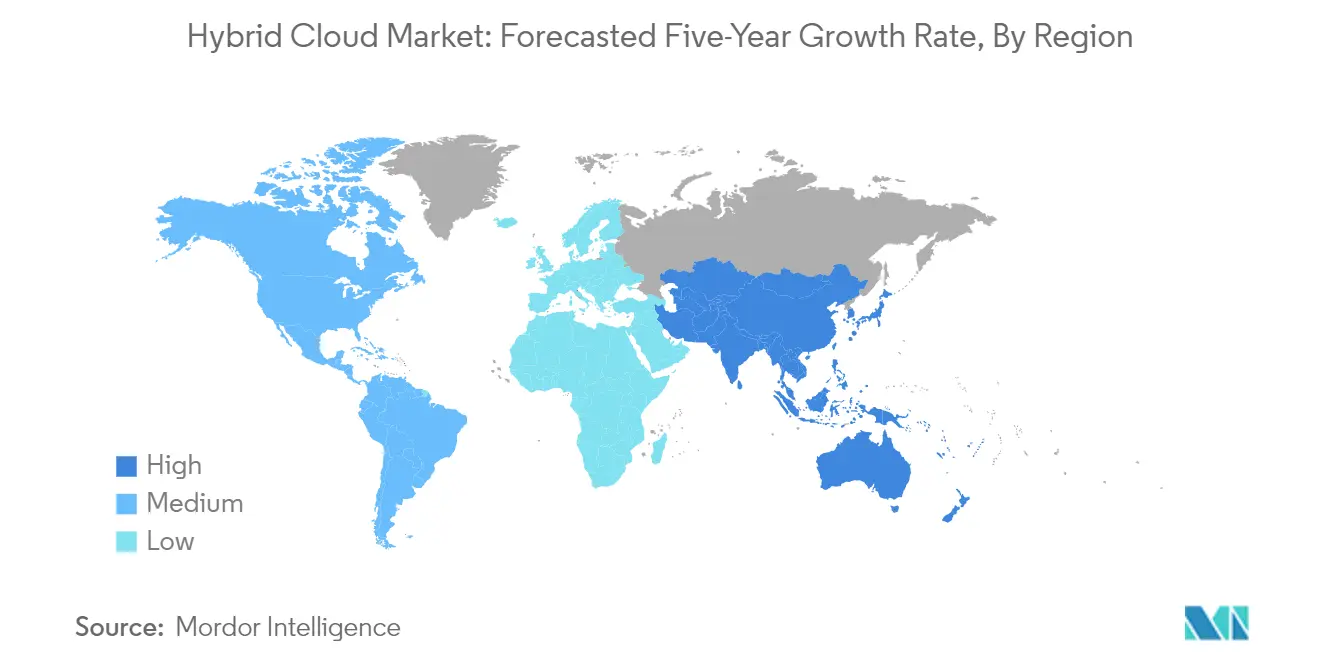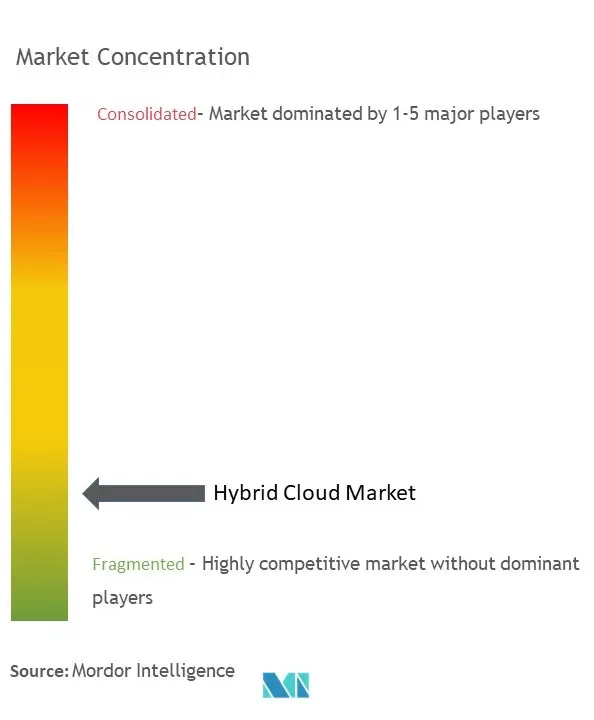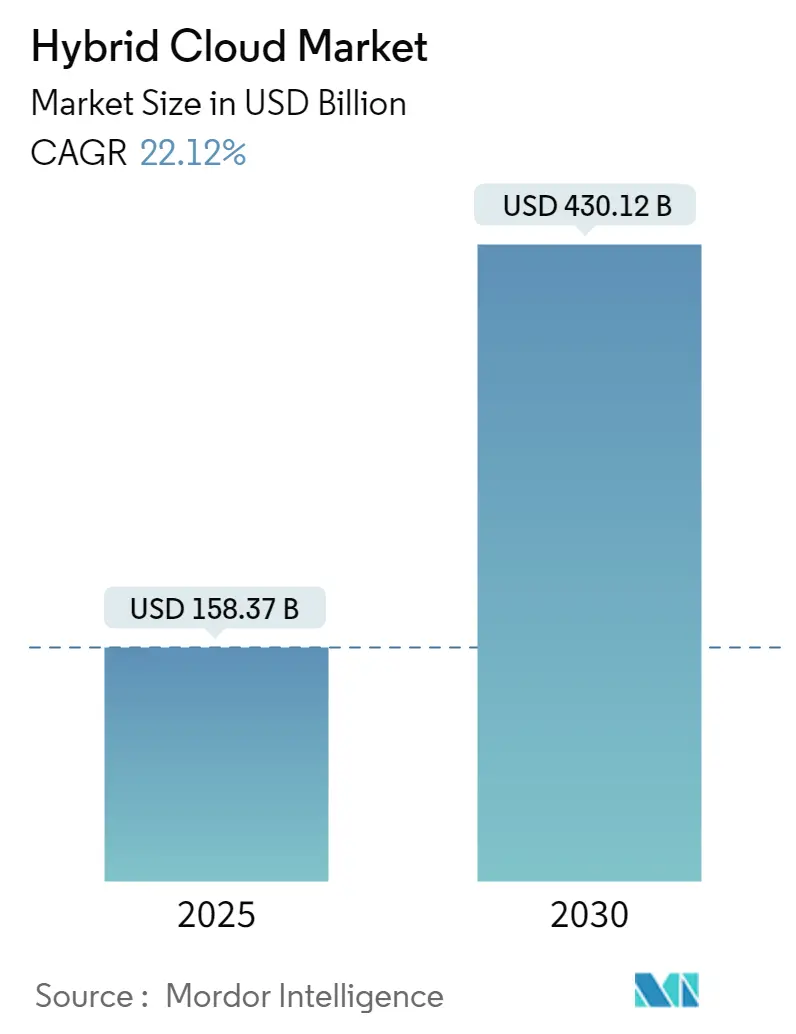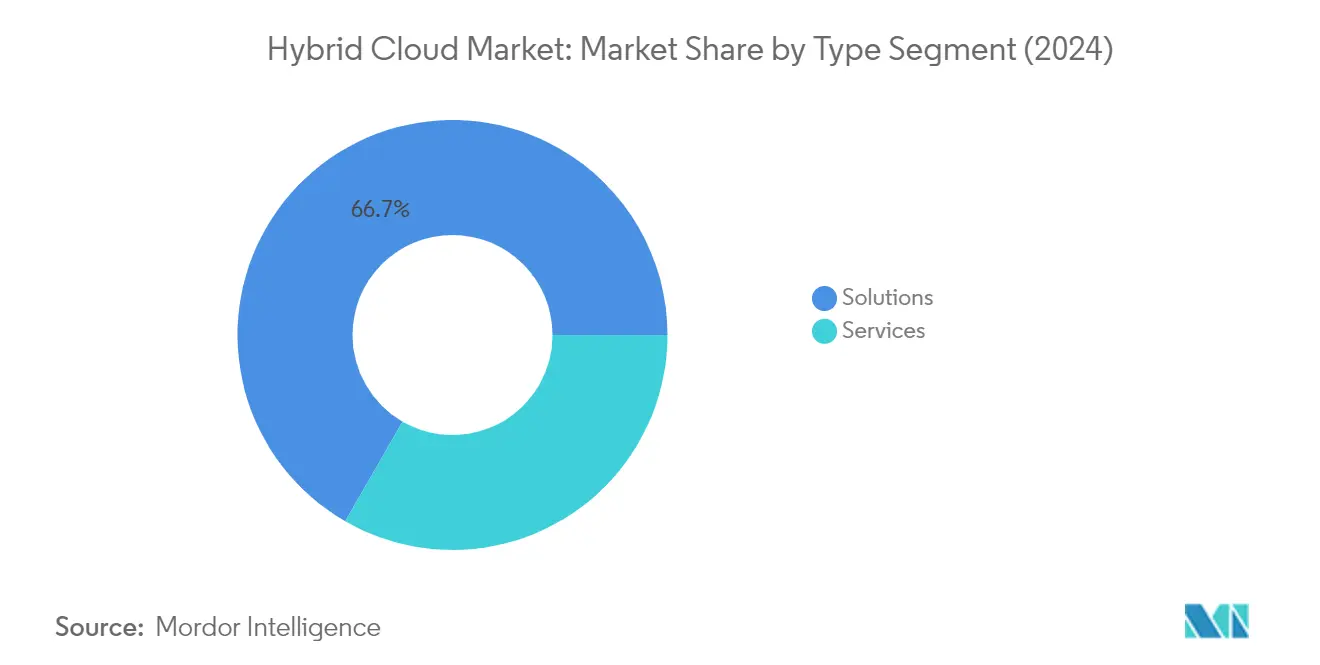Hybrid Cloud Market Size
Hybrid Cloud Market Analysis
The Hybrid Cloud Market size is estimated at USD 158.37 billion in 2025, and is expected to reach USD 430.12 billion by 2030, at a CAGR of 22.12% during the forecast period (2025-2030).
The hybrid cloud landscape is experiencing a fundamental shift as organizations increasingly recognize the strategic value of flexible cloud infrastructure solutions. According to Flexera Software's State of Cloud 2023, 72% of enterprise respondents indicated that hybrid cloud would be implemented in their organizations, highlighting the growing mainstream adoption of hybrid architectures. This transformation is particularly evident in the telecommunications sector, where the convergence of 5G technology and hybrid cloud solutions is creating new opportunities for innovation and service delivery. The integration of edge computing capabilities with hybrid cloud infrastructure is enabling organizations to process data closer to the source, reducing latency and improving real-time decision-making capabilities.
The evolution of hybrid cloud solutions is closely tied to the advancement of network infrastructure and connectivity. According to 5G Americas, there were 1.9 billion fifth-generation (5G) subscriptions worldwide in 2023, creating a robust foundation for hybrid cloud deployment. Major technology providers are responding to this trend with enhanced offerings, as evidenced by IBM's acquisition of Agyla SAS in June 2023 to extend its hybrid cloud expertise in France, and HPE's expanded partnership with AWS to provide customers with a consistent, dependable hybrid cloud solution. These strategic moves reflect the industry's commitment to developing more sophisticated and integrated hybrid cloud solutions.
The complexity of modern IT environments has necessitated more sophisticated approaches to cloud management. According to Cisco's 2022 Global Hybrid Cloud Trends Report, 79% of business workloads operate on diverse hardware across environments, highlighting the need for unified management solutions. In response to this challenge, significant innovations have emerged, such as IBM's launch of Hybrid Cloud Mesh in May 2023, a SaaS product designed to help organizations manage their hybrid multi-cloud architecture, and Microsoft's introduction of its next-generation hybrid cloud platform "Azure Operator Nexus" in February 2023 for communication service providers.
The transformation of workplace dynamics has significantly influenced hybrid cloud adoption patterns across industries. Organizations are increasingly leveraging hybrid cloud solutions to support distributed workforce models while maintaining cloud security and compliance requirements. This shift is particularly evident in the financial services sector, where institutions are utilizing hybrid cloud architectures to balance the need for data security with the demands for operational flexibility. The trend is supported by strategic initiatives from major cloud computing providers, such as HPE's platform enhancements and new cloud services for HPE GreenLake in June 2023, which offers organizations greater choice, flexibility, and predictability in their cloud service delivery.
Hybrid Cloud Market Trends
Rising Need for Interoperability Standards Between cloud services and Existing Systems
The increased use of cloud computing and the integration of cloud services with on-premises infrastructure are driving the demand for interoperability standards between cloud services and current systems. Organizations frequently utilize a variety of cloud services, applications, and systems to satisfy their diverse demands, making it crucial for these different components to interact and share information effectively. The ability of various systems, applications, or services to interact, share information, and collaborate successfully has become paramount, especially as enterprises seek to maintain their legacy systems while adopting modern cloud solutions. For instance, in June 2023, Hewlett Packard Enterprise announced platform enhancements and new cloud services for HPE GreenLake, providing clients with greater options, flexibility, and predictability in their business cloud services delivery.
The interoperability challenge has become more pronounced as organizations implement hybrid cloud or multi-cloud strategies that combine on-premises systems with public cloud services. According to Flexera Software's State of Cloud 2023, 72% of corporate respondents claimed hybrid cloud would be used in their firm, highlighting the critical need for seamless integration. To address these challenges, major technology providers are developing comprehensive solutions. For example, in May 2023, IBM introduced IBM Hybrid Cloud Mesh, a SaaS offering designed to enable enterprises to bring management to their hybrid multi-cloud infrastructure, automating the process, management, and observability of application connectivity between different environments.
The Ability to Offer Improved Business Performance and Greater Return on Investments as Businesses Embrace Digitalization
Digitalization and the adoption of hybrid cloud solutions significantly enhance business operational performance and increase return on investment (ROI). Organizations can simply and swiftly scale their IT infrastructure up or down based on their unique demands due to hybrid cloud environments, enabling them to react quickly to evolving market conditions, customer demands, or seasonal changes. This scalability and adaptability allow companies to more effectively allocate their resources, reduce expenses, and boost ROI. The banking sector, in particular, has witnessed substantial benefits, with hybrid cloud adoption leading to cost reduction, increased efficiency, and better customer management capabilities.
The integration of emerging technologies with hybrid cloud solutions is further driving business performance improvements. Organizations are increasingly leveraging the benefits of edge computing, the Internet of Things (IoT), and artificial intelligence through hybrid cloud implementations. For instance, in April 2023, IBM announced the acquisition of Agyla SAS, a premier cloud professional services provider in France, to extend IBM Consulting's regional cloud expertise and enhance the company's hybrid cloud services and artificial intelligence ambitions. Additionally, companies are constructing more robust infrastructure in response to increased demand, with significant investments in new technologies and solutions to gain competitive advantages. The hybrid cloud enables faster innovation cycles and quicker time-to-market for new products and services, allowing businesses to experiment, iterate, and deploy new solutions more rapidly through cloud-native technology and DevOps practices.
Segment Analysis: By Type
Solutions Segment in Hybrid Cloud Market
The Solutions segment maintains its dominant position in the hybrid cloud market, commanding approximately 67% of the total market share in 2024. This segment encompasses hybrid cloud management software solutions, hosting services, and cloud security components that are crucial for enterprise deployments. The substantial market share reflects the growing preference among organizations for comprehensive cloud solutions packages that enable seamless cloud integration between existing on-premises infrastructure and public cloud services. Many organizations, particularly those with legacy systems and applications that cannot be easily migrated to the public cloud due to regulatory and technical constraints, are increasingly adopting hybrid cloud solutions. The segment's strength is further reinforced by the rising demand for edge computing capabilities, where hybrid cloud solutions facilitate the integration of edge computing with centralized cloud infrastructure, enabling organizations to process and analyze data at the edge while leveraging the scalability and storage capabilities of the cloud.
Services Segment in Hybrid Cloud Market
The Services segment is experiencing remarkable growth in the hybrid cloud market, projected to expand at approximately 17% during the forecast period 2024-2029. This accelerated growth is driven by the increasing complexity of cloud computing technologies and the growing need for specialized expertise in managing hybrid cloud environments. The services segment encompasses installation services, management services, and networking and consulting services, all of which are becoming increasingly critical as organizations navigate their digital transformation journeys. The shift towards remote work and hybrid workforce models has significantly boosted the demand for professional services, as organizations seek expert guidance in implementing and managing flexible IT infrastructure. Service providers are expanding their offerings to include comprehensive support packages, from infrastructure management to performance monitoring and resource optimization, addressing the growing need for managed services in hybrid cloud deployments.
Segment Analysis: By End-User Industry
BFSI Segment in Hybrid Cloud Market
The Banking, Financial Services, and Insurance (BFSI) sector maintains its dominance in the hybrid cloud market, commanding approximately 26% market share in 2024. This significant market position is driven by the sector's critical need for secure and compliant infrastructure to handle sensitive financial data while maintaining operational efficiency. Financial institutions are increasingly leveraging hybrid cloud solutions to achieve greater scalability and integrated communication between disparate systems, particularly as they modernize their legacy technologies. The hybrid cloud model enables banks to migrate critical banking processes and applications to private clouds for enhanced security while moving non-critical applications to the public cloud for cost efficiency and agility. This approach allows BFSI organizations to effectively manage their customer data, optimize costs, and maintain regulatory compliance while supporting their digital transformation initiatives.
ICT Segment in Hybrid Cloud Market
The Information and Communication Technology (ICT) segment is experiencing the most rapid growth in the hybrid cloud market, with projections indicating robust expansion between 2024 and 2029. This accelerated growth is primarily driven by the sector's increasing focus on data security, operational efficiency, and the need to manage exponentially growing data volumes. ICT companies are actively adopting hybrid cloud solutions to safeguard data integrity while ensuring smooth operations, particularly in response to the growing implementation of IoT, 5G communications, and edge computing technologies. The segment's growth is further bolstered by strategic partnerships between cloud services providers and telecom companies, enabling organizations to leverage both on-premises infrastructure and cloud resources effectively while maintaining optimal performance and security standards.
Remaining Segments in End-User Industry
The hybrid cloud market encompasses several other significant segments including Government and Public Sector, Healthcare, Retail, and Media and Entertainment, each contributing uniquely to market dynamics. The Government and Public Sector segment is driven by the need for enhanced security and digital transformation initiatives, while Healthcare organizations are leveraging hybrid cloud solutions to manage sensitive patient data and improve operational efficiency. The Retail sector is utilizing hybrid cloud infrastructure to support e-commerce operations and enhance customer experiences, while the Media and Entertainment industry relies on cloud storage solutions for content delivery and storage optimization. These segments collectively demonstrate the versatility and broad applicability of hybrid cloud solutions across different industry verticals.
Hybrid Cloud Market Geography Segment Analysis
Hybrid Cloud Market in North America
North America continues to maintain its position as a dominant force in the hybrid cloud market, holding approximately 31% of the global market share in 2024. The region's leadership is driven by its highly sophisticated cloud computing infrastructure, with organizations across all industries actively embracing hybrid cloud solutions. The presence of major technology giants and cloud services providers has created a robust ecosystem that supports innovation and adoption. North American organizations are particularly focused on digital transformation initiatives, leveraging hybrid cloud solutions to modernize their IT infrastructure while maintaining compliance with stringent data security regulations. The region's strong emphasis on cloud security, coupled with the need for flexible and scalable IT solutions, has accelerated the adoption of hybrid cloud architectures. Furthermore, the widespread implementation of bring-your-own-device (BYOD) policies and remote work solutions has reinforced the necessity for hybrid cloud deployments that can securely bridge on-premises and cloud environments. The market's growth is also supported by substantial investments in cloud infrastructure and a well-developed network of channel partners and solution providers.

Hybrid Cloud Market in Europe
Europe represents a rapidly evolving market for hybrid cloud solutions, demonstrating a robust historical growth rate of approximately 14% from 2019 to 2024. The region's hybrid cloud landscape is characterized by a strong focus on data protection and regulatory compliance, particularly with GDPR requirements. European businesses are actively pursuing digital transformation initiatives to maintain competitiveness in the global market, with hybrid cloud solutions playing a central role in this evolution. The region's approach to cloud adoption is marked by a careful balance between innovation and data sovereignty concerns, leading to the development of sophisticated hybrid cloud architectures. Organizations across various sectors are leveraging hybrid cloud solutions to modernize their IT infrastructure while maintaining control over sensitive data. The market is further strengthened by increasing government initiatives supporting cloud adoption and digital transformation. European enterprises particularly value the flexibility and security aspects of hybrid cloud solutions, which allow them to maintain compliance with regional data protection regulations while accessing advanced cloud capabilities.
Hybrid Cloud Market in Asia Pacific
The Asia Pacific region represents one of the most dynamic and fastest-growing markets for hybrid cloud solutions, with a projected growth rate of approximately 17% from 2024 to 2029. The region's hybrid cloud market is being driven by rapid digital transformation across multiple industries and a growing recognition of the benefits of hybrid cloud architectures. Countries like China, Japan, and India are leading the charge in hybrid cloud adoption, supported by significant investments in digital infrastructure and government initiatives promoting cloud technology. The market is characterized by a strong focus on cost-effective solutions that can support the region's expanding digital economy while addressing unique local challenges. Organizations in the Asia Pacific region are increasingly leveraging hybrid cloud solutions to enhance their operational efficiency and competitive advantage. The region's diverse regulatory landscape and varying levels of technological maturity across countries have led to the development of flexible hybrid cloud solutions that can adapt to different market requirements. The presence of major global cloud providers and local players has created a competitive environment that fosters innovation and drives market growth.
Hybrid Cloud Market in Latin America
Latin America's hybrid cloud market is experiencing significant transformation as organizations increasingly recognize the value of combining public and private cloud environments. The region's market is characterized by a growing emphasis on digital innovation and modernization of IT infrastructure. Organizations across various sectors are adopting hybrid cloud solutions to address their specific business needs while maintaining control over sensitive data and applications. The market is being driven by factors such as the need for improved operational efficiency, enhanced data security, and the ability to scale resources according to demand. Financial institutions and government organizations in particular are showing strong interest in hybrid cloud solutions, recognizing their potential to modernize services while maintaining compliance with local regulations. The region's telecommunications infrastructure improvements and increasing internet penetration are creating favorable conditions for hybrid cloud adoption. Additionally, the presence of major cloud service providers and their partnerships with local entities is helping to establish a robust ecosystem for hybrid cloud services.
Hybrid Cloud Market in Middle East & Africa
The Middle East and Africa region presents a growing market for hybrid cloud solutions, characterized by increasing digital transformation initiatives and government-led cloud adoption programs. The region's hybrid cloud landscape is evolving rapidly, driven by organizations seeking to modernize their IT infrastructure while maintaining control over sensitive data. Government entities and large enterprises are leading the adoption of hybrid cloud solutions, particularly in sectors such as banking, telecommunications, and public services. The market is benefiting from significant investments in digital infrastructure and the establishment of local data centers by major cloud providers. Organizations in the region are particularly attracted to hybrid cloud solutions for their ability to balance the benefits of cloud computing with local data sovereignty requirements. The market is also seeing increased activity in smart city initiatives and public sector digitization projects, which are creating new opportunities for hybrid cloud deployment. The region's diverse economic landscape and varying levels of technological maturity are leading to the development of customized hybrid cloud solutions that address specific market needs.
Hybrid Cloud Industry Overview
Top Companies in Hybrid Cloud Market
The hybrid cloud market features prominent technology leaders, including IBM, Microsoft, AWS, Google Cloud, and VMware, who are driving innovation through continuous product development and strategic partnerships. These hybrid cloud companies are focusing on expanding their hybrid cloud capabilities through investments in cloud infrastructure modernization, edge computing integration, and enhanced security features. Market leaders are emphasizing operational agility by developing automated deployment tools, self-service platforms, and simplified management interfaces for hybrid environments. Strategic moves in the industry include strengthening partner ecosystems, developing industry-specific solutions, and expanding geographical presence through data center investments. Companies are also prioritizing sustainability initiatives and compliance frameworks while enhancing their service delivery models to address the evolving needs of enterprises across various sectors.
Dynamic Market with Strong Consolidation Trends
The hybrid cloud market exhibits a complex competitive structure characterized by both global technology conglomerates and specialized hybrid cloud vendors. Large technology corporations leverage their extensive infrastructure and research capabilities to offer comprehensive cloud solutions, while specialized providers focus on niche segments and specific industry verticals. The market demonstrates moderate consolidation, with major players actively pursuing strategic acquisitions to enhance their technological capabilities and expand their service portfolios. These acquisitions particularly target companies specializing in cloud security, automation, artificial intelligence, and managed services.
The competitive landscape is further shaped by strategic alliances and partnerships between cloud computing providers, hardware manufacturers, and system integrators. Regional players are gaining prominence by offering localized solutions and addressing specific regulatory requirements in their respective markets. The industry witnesses continuous evolution through collaborative innovations, with companies forming technology partnerships to develop integrated solutions and expand their market reach. Market participants are increasingly focusing on developing industry-specific expertise and solutions, particularly in highly regulated sectors such as healthcare, financial services, and government.
Innovation and Adaptability Drive Market Success
Success in the hybrid cloud market increasingly depends on providers' ability to deliver seamless cloud integration capabilities, enhanced security features, and flexible deployment options. Companies must focus on developing comprehensive service portfolios that address specific industry requirements while maintaining compatibility with existing IT infrastructure. Market leaders are strengthening their positions by investing in advanced technologies like artificial intelligence and machine learning to enhance automation capabilities and improve operational efficiency. The ability to provide robust data governance frameworks, ensure regulatory compliance, and maintain high service availability has become crucial for maintaining competitive advantage.
For emerging players and contenders, success lies in identifying and serving underserved market segments while developing specialized solutions that address specific customer pain points. Companies must focus on building strong partner ecosystems and developing innovative pricing models to compete effectively. The market shows moderate end-user concentration, with enterprises increasingly seeking vendors who can provide comprehensive solutions while maintaining flexibility and scalability. Regulatory requirements, particularly around data sovereignty and privacy, continue to shape market dynamics and influence provider strategies. Companies must also address the growing demand for sustainability and environmental responsibility while maintaining competitive pricing and service quality.
Hybrid Cloud Market Leaders
-
Cisco Systems Inc.
-
Hewlett Packard Enterprise Company
-
Amazon Web Services (Amazon Inc.)
-
Accenture PLC
-
IBM Corporation
- *Disclaimer: Major Players sorted in no particular order

Hybrid Cloud Market News
- April 2023: DXC Technology announced the release of DXC Secure Network Fabric, a hybrid cloud-optimized comprehensive data center platform. DXC Secure Network Fabric, developed in conjunction with Hewlett Packard Enterprise and AMD, is a comprehensive software-defined data center system that automates, modernizes, simplifies, and secures the data center networks at a reduced cost.
- January 2023: Hybrid cloud data management and storage technology vendor, Cloudian closed a fund-raising round of USD 60 million which was to be used to scale the company inorder to meet an increasing number of use cases. The fund-raising round includes investments from multiple investment firms and Intel Capital, and other strategic investors. The total funding in Cloudian reached USD 233 million.
Hybrid Cloud Industry Segmentation
A hybrid cloud refers to a model or approach in information technology (IT) infrastructure. A hybrid cloud integrates public cloud services, private cloud services, and on-premises infrastructure. It also provides orchestration, management, and application portability.
The hybrid cloud market is segmented by type (solutions, services), end-user industry (government & public sector, healthcare, BFSI, retail, information & communication technology, media & entertainment), and geography (North America, Europe, Asia Pacific, Latin America, Middle East & Africa). The market sizes and forecasts are provided in terms of value (USD) for all the segments.
| By Type | Solutions |
| Services | |
| By End-user Industry | Government and Public Sector |
| Healthcare | |
| Banking, Finance, Services, and Insurance (BFSI) | |
| Retail | |
| Information and Communication Technology | |
| Media and Entertainment | |
| Other End-user Industries | |
| By Geography | North America |
| Europe | |
| Asia Pacific | |
| Latin America | |
| Middle East and Africa |
Hybrid Cloud Market Research FAQs
How big is the Hybrid Cloud Market?
The Hybrid Cloud Market size is expected to reach USD 158.37 billion in 2025 and grow at a CAGR of 22.12% to reach USD 430.12 billion by 2030.
What is the current Hybrid Cloud Market size?
In 2025, the Hybrid Cloud Market size is expected to reach USD 158.37 billion.
Who are the key players in Hybrid Cloud Market?
Cisco Systems Inc., Hewlett Packard Enterprise Company, Amazon Web Services (Amazon Inc.), Accenture PLC and IBM Corporation are the major companies operating in the Hybrid Cloud Market.
Which is the fastest growing region in Hybrid Cloud Market?
Asia Pacific is estimated to grow at the highest CAGR over the forecast period (2025-2030).
Which region has the biggest share in Hybrid Cloud Market?
In 2025, the North America accounts for the largest market share in Hybrid Cloud Market.
What years does this Hybrid Cloud Market cover, and what was the market size in 2024?
In 2024, the Hybrid Cloud Market size was estimated at USD 123.34 billion. The report covers the Hybrid Cloud Market historical market size for years: 2019, 2020, 2021, 2022, 2023 and 2024. The report also forecasts the Hybrid Cloud Market size for years: 2025, 2026, 2027, 2028, 2029 and 2030.
Our Best Selling Reports
Hybrid Cloud Market Research
Mordor Intelligence brings extensive expertise in analyzing the hybrid cloud landscape. We offer comprehensive insights into the convergence of public cloud and private cloud technologies. Our research thoroughly examines the evolution of cloud computing solutions, including SaaS, PaaS, and IaaS implementations across various industries. The report provides a detailed analysis of cloud infrastructure, cloud security, and cloud services markets. It focuses particularly on hybrid infrastructure developments and cloud transformation initiatives.
Stakeholders can access our easy-to-read report PDF, which delivers actionable insights into cloud computing industry trends and hybrid cloud market trends. The analysis covers key aspects of cloud integration, cloud orchestration, and cloud automation. This helps businesses optimize their cloud deployment strategies. Our research examines leading hybrid cloud companies and cloud solutions providers, offering detailed perspectives on cloud migration, cloud networking, and distributed cloud technologies. The report also includes comprehensive coverage of enterprise cloud adoption patterns and cloud management practices. This enables organizations to make informed decisions about their cloud infrastructure investments.





